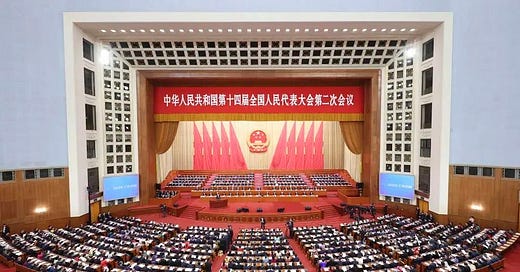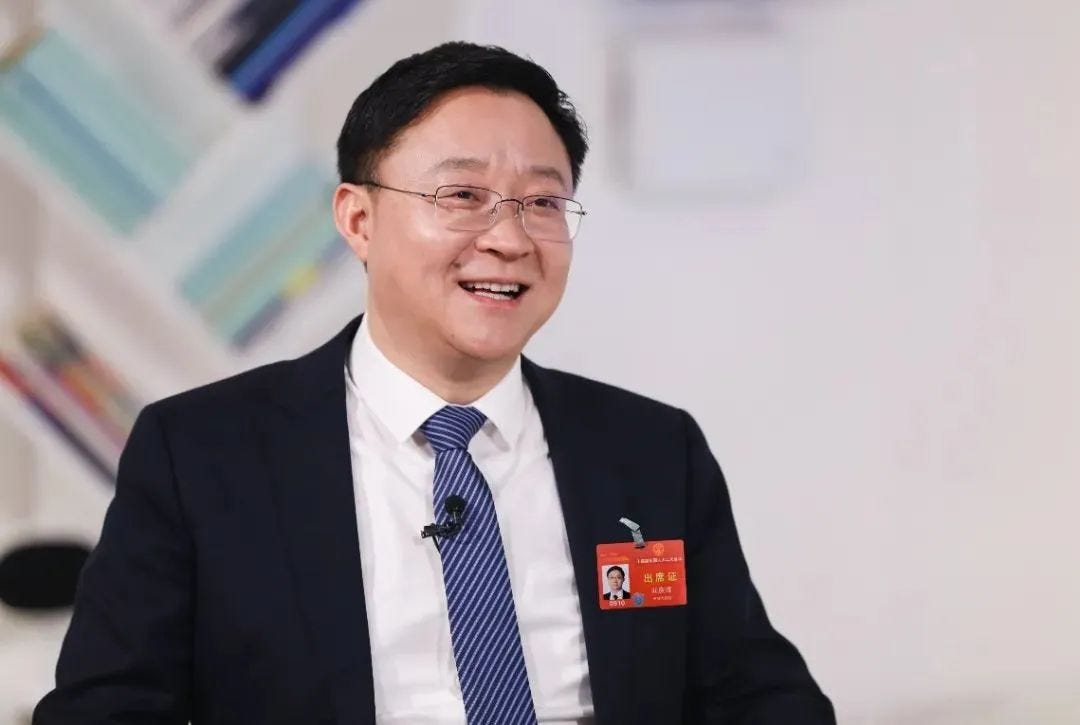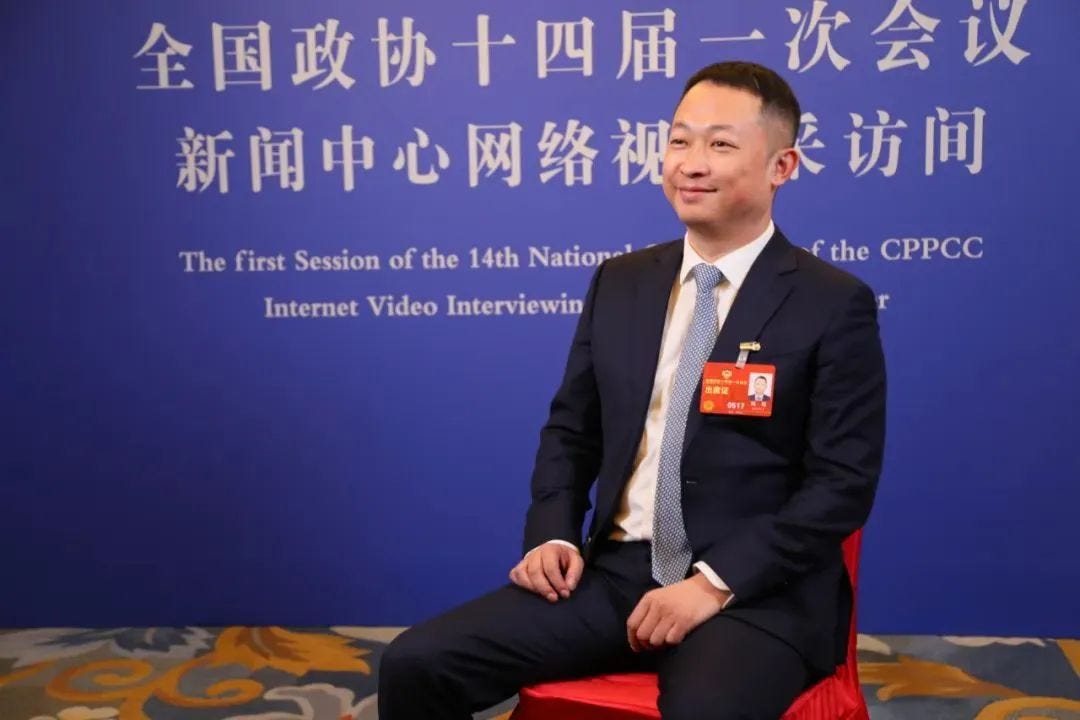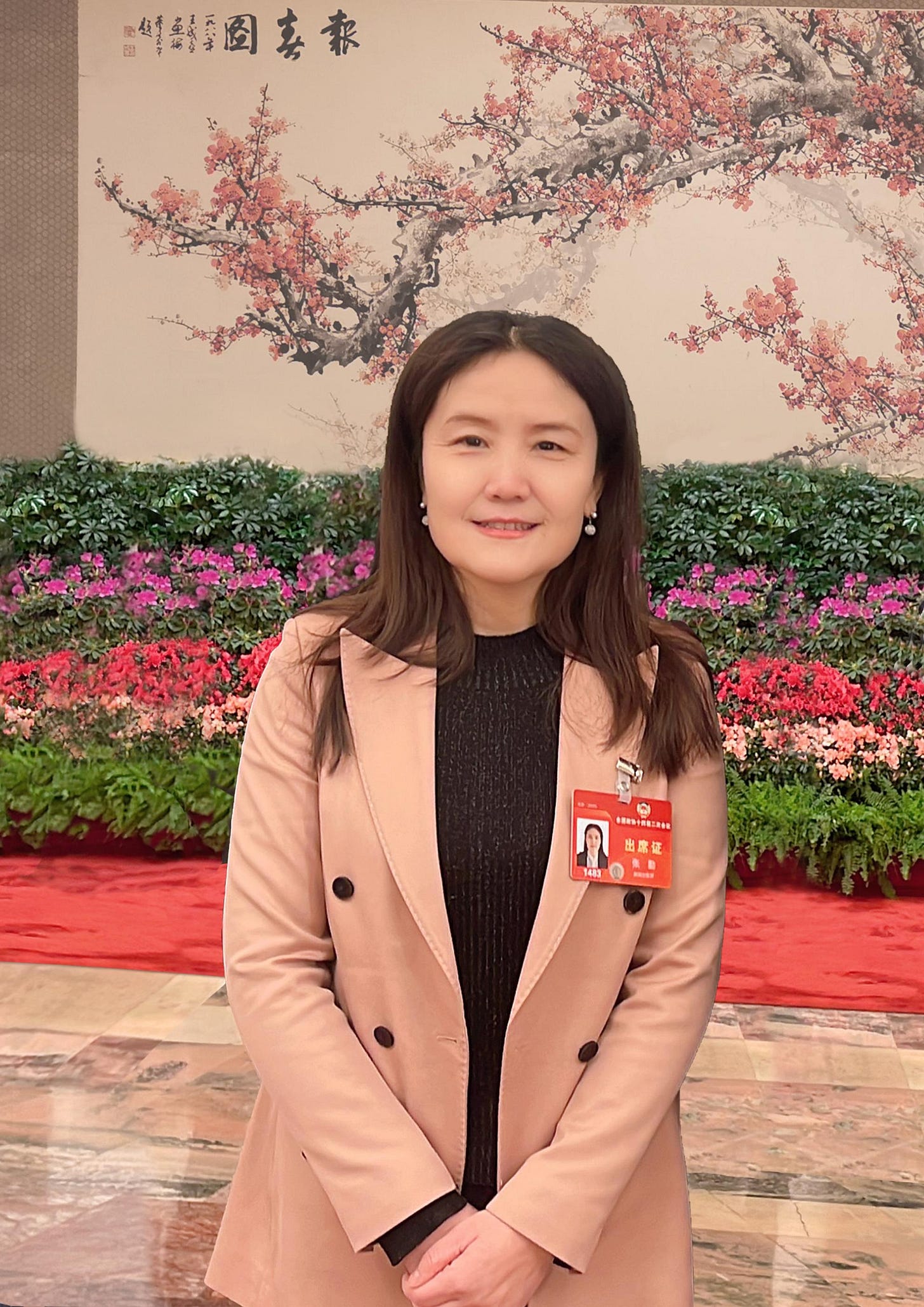Two Sessions on AI: Strategy, Security, and Sovereignty
All the AI takes from China’s elite at Two Sessions
Nancy Yu delivers the most comprehensive coverage to date of all the important AI proposals coming out of Beijing — Li Qiang’s “AI+ Initiative,” “sovereign AI,” “new quality productive forces” and AI, the pursuit (and dangers) of AGI, AI security, and generative AI erasing Chinese culture.
Earlier this month, Chinese tech executives and academicians convened in Beijing to weigh in on the country’s AI strategy at the annual plenary meetings of the National People’s Congress (NPC) and Chinese People’s Political Consultative Conference (CPPCC) — a central event in China’s political calendar known as the Two Sessions 两会.
While the actual legislative power of the institutions is limited — the CPPCC is a policy-consultation institution, and the NPC pretty much obeys Party directives — the annual Two Sessions still give individuals outside the Party-state a chance to engage in the nation’s law-making process.
Delegates to the CPPCC and the NPC are not only professional politicians from regional administrations, but also from social elites — like prominent tech CEOs or esteemed professors — who have risen to prominence outside of the political machine. During the Two Sessions, they can put their opinions on the table and submit proposals for national policy. While the specific texts of the proposals are not available to the public, the comprehensive coverage by Chinese media offers international observers a glimpse into these social elites’ perspectives on China’s trajectory.
The cliffnotes of this year’s Two Sessions AI-related proposals:
Most delegates interpret the “AI+ Initiative” in Premier Li Qiang’s 李强 work report in terms of AI’s potential to enhance industrial productivity. They believe China’s advantage lies in developing applications for AI, not foundational research. Only a handful of delegates mentioned AGI research.
To attain “sovereign AI,” delegates believe that China needs to overcome bottlenecks in computing power, data infrastructure, and talent development. Relatively few mention basic research in AI algorithms and architecture.
CEOs from internet-security companies recommend that the government develop more mature security-assessment standards for AI models, as well as invest in companies with the capabilities to address AI security concerns effectively.
The AI+ Initiative
The AI+ Initiative is one of the key initiatives outlined in Premier Li Qiang’s government work report. While little detail on the Initiative is public, the fervent discussions among the delegates give a window into what the state has in mind.
Most delegates see the AI+ Initiative as a part of the government’s ongoing effort to upgrade and modernize China’s industrial system. To them, a key goal of the Initiative is to convert advancement in AI technology into tangible productivity in the real economy.
Zhou Hongyi 周鸿祎 — a CPPCC delegate, and the founder and CEO of Chinese internet-security company Qihoo 奇虎 360 — believes that China should focus on developing AI application scenarios. “The competition between China and the United States in the field of artificial intelligence is twofold,” Zhou told Chinese Business Network. “On one hand, it is a battle against OpenAI’s foundational models; and on the other hand, it is a battle for [developing] differentiated and specialized AI applications. Currently, China needs more time to catch up with the United States in the foundation technology of general-purpose AI models. In terms of AI applications, however, the year 2024 marks year zero of developing AI application scenarios, and China can develop a path for AI development with Chinese characteristics.”
Zhou submitted a suggestion that aims to integrate AI with the real economy through developing “multi-scenario application,” “industrial application,” and “verticalization” of AI models. Key elements of the proposal include,
Government and state-owned enterprises should lead the way in providing more application scenarios, focusing on “small incisions with deep penetration” 小切口、大纵深, to promote the verticalization and industrialization of LLMs, and to assist the digital and intelligent transformation of a myriad of industries.
Encourage enterprises to manage knowledge properly and upgrade business big-data platforms to business knowledge platforms before customizing LLMs. On this basis, through vertical training, deeply integrate with business-level scenarios to meet businesses’ needs.
Motivate and guide businesses to deeply integrate LLMs with digital business systems and combine them with business processes to fully leverage the value of large models.
Similarly, Qian Feng 钱锋, a CPPCC delegate and professor at the Chinese Academy of Engineering 中国工程院, hopes to orient policymakers’ attention to the manufacturing industry:
In my view, a new round of industrialization powered by AI involves using data, algorithms, and computing power to address urgent challenges in the high-quality development of manufacturing. In this context, artificial intelligence is merely a tool and means. The key lies in understanding the needs, difficulties, and weaknesses of the manufacturing industry, and closely integrating AI technology with these areas to find solutions, rather than treating AI and manufacturing development as two separate entities 两张皮.
We need to guide enterprises in the real economy to deeply integrate with artificial intelligence technologies, to extensively harness the value of data, efficiently allocate resources and energy, precisely manage safety, environmental, and quality controls, make effective decisions based on data, and deeply empower the industrial chain. By doing so, we aim to create a “new-quality real economy based on intelligent manufacturing” 智造新实体.
A review of the delegates’ proposals surrounding the AI+ Initiative suggests that China’s industrial leaders tend to discuss the latest AI revolution in terms of its potential to upgrade industrial productivity. This is in line with the official discourse on AI. In his work report to the NPC, Premier Li Qiang positioned developing “new quality productive forces” 新质生产力 as the primary objective for the government in 2024. Coined by Xi Jinping during an inspection trip last September and subsequently highlighted at multiple high-level Party meetings, the concept of new quality productive forces refers to a development path driven by revolutionary technological breakthroughs, industrial upgrade, and a dramatic increase in economic productivity. To pursue Xi’s ambitious vision, the Premier pledged that the government would “upgrade industrial and supply chain,” “foster emerging industries,” and “promote the innovative development of the digital economy.”
With the government focused on the nation’s industrial capability, proposals on basic research of AI algorithms and architectures related to artificial general intelligence (AGI) tend to get sidelined. Compared to last year’s Two Sessions — where some delegates cheered for an AGI moonshot — most delegates this year view AGI as a distant goal, detached from China’s economic reality.
Liu Qingfeng 刘庆峰 stands out as an exception. Liu is the founder and chairman of iFlytek 科大讯飞, a partially state-owned enterprise based in Hefei 合肥 best known for its voice-recognition software — and to the US human-rights sanctionists, its involvement in the state-surveillance program in Xinjiang. Liu believes that Chinese developers should not shy away from competing with US companies for the most advanced AI technology, and further, that the AI+ Initiative should entail the pursuit of artificial general intelligence (AGI). As he expressed to China Economic News:
Artificial general intelligence (AGI) is the focal point of global technological competition, as well as a must-win for the Sino-American technology and strategic rivalry. The “main battlefield” of the Sino-American rivalry lies in the continuous benchmarking of general foundational capabilities [from each country]. Presently, OpenAI’s GPT-4/4V represents state-of-art LLM foundational capabilities, with DALL·E 3, Whisper, Sora, and others being successful applications in specific fields based on the foundation of GPT-4/4V.
[Consider] China’s first LLM trained entirely on domestically produced computing power, the iFlytek Sparkle Model, [which I] estimate can reach the current best level of GPT-4/4V within six months. With the release of GPT-5, however, this gap might extend to over a year. If resources in computing power, data, and model training are well organized and fully pursued, this gap could potentially be closed to a comparable level within one to two years.
Liu believes that the AGI research gap between China and the US is worrisome. In his proposal, Liu suggests that the state should pursue AGI by investing in basic research on AI algorithms and architecture, computational infrastructure, domestic open-source platforms, data infrastructure, as well as special research projects on ethical questions related to AGI. To him, the global technological competition is a race to developing AGI.
Sovereign AI
To secure an AI-powered industrial revolution, the delegates recommended the government coordinate industrial and academic resources to building China’s “sovereign AI.”
Referencing a recent Nvidia post on sovereign AI, CPPCC member and CAS Institute of Computing Technology 计算技术研究所 research fellow Zhang Yunquan 张云泉 defined sovereign AI — or “sovereign-level foundational large models” 主权级基础大模型 — as a nation’s capabilities to produce artificial intelligence using its own infrastructure, data, workforce and business networks. “Sovereign-AI capabilities can affect the entire country’s technological competitiveness, including military, political, and economic, and other aspects, in the international community,” Global Times quotes Zhang. “If we fall behind in this regard, we may face the risk of being sanctioned and suppressed.”
To the tech delegates, securing China’s sovereign AI capability requires the nation to overcome bottlenecks in three areas:
hardware,
data infrastructure,
and talent.
In terms of hardware, Zhang argued that China needs to use a whole-of-nation approach to concentrate its limited computing power:
Currently, some domestic companies tend to use foreign open-source large models, often resulting in low-level duplication and “internal competition” 内卷. The battle among hundreds of models 百模大战 has led to the over-dispersion of computational resources, delaying the development of “sovereign-level foundational large models.” Whether it’s the specialized supercomputing projects or the AI chip breakthrough projects, there is a need for the state to coordinate resources, forming teams in the manner of the historical “Two Bombs, One Satellite” 两弹一星 initiative to achieve rapid breakthroughs. The window of opportunity left for us is not long — we cannot afford to miss the chance.
Others agreed with Zhang’s assessment. According to Cao Peng 曹鹏 — a CPPCC delegate and the chairman of the technology committee of JD.com 京东, one of China’s largest e-commerce companies — computing power is the key to the global AI race. He stressed the critical need for domestic alternatives to imported chips in response to intensifying US restrictions. In particular, Cao recommended that the government encourage the use of domestically manufactured GPUs with local computing power scheduling software, aiming to establish a computing base that is self-reliant and independently managed.
In an interview with Time Finance 时代财经, Cao asserted that JD.com offered a viable model to overcome the hardware challenge:
Since last year, domestic GPUs have continued to strengthen, making substantial progress in chip design, technology, computing power, and ecosystem. To catch up with the gap compared to overseas technologies, I believe the most crucial aspect is “to start using them.” The production and R&D of GPUs are critical, and large model training needs to be based on GPUs as the computing foundation — but only widespread application can quickly drive continuous iterations of product technology.
JD.com’s production environment is actively engaged in the practice of domestication 国产化. For domestic chips, including domestic GPUs, we have made extensive software and configuration optimizations. Also, before going live with our services, we conduct comprehensive testing and verification through chaos engineering platforms. After launching, we use end-to-end monitoring tools for timely detection and troubleshooting of anomalies.
Currently, JD Group’s retail, logistics, and financial services are using tens of thousands of cores of domestic products. 90% of JD’s applications support stable operations on domestically produced infrastructure, also achieving the industry’s first full-stack domestic product support for the CCTV Spring Festival Gala red packet interactive activity.
In addition to the hardware problem, Zhou Yuan 周源, a CPPCC delegate and the founder and CEO of Zhihu 知乎 (a Chinese equivalent of Quora), pointed to the lack of mature infrastructure for Chinese-language training data:
Despite the abundance of domestic data resources, the current lack of data mining and the inability to freely circulate in the market mean that high-quality Chinese data remains scarce. For instance, in the training data for ChatGPT, Chinese materials account for less than 0.1%, while English materials make up more than 92.6%.
This has led many domestic research institutions and companies involved in the development of large models to rely on foreign language annotated datasets, open-source datasets, or scraped web data for model training.
Zhou Yuan told reporters from the 21st Century Business Herald that solving the shortage of Chinese corpus resources should ideally start with building a “reservoir” and then proceed to its rational use. However, industry has not placed enough emphasis on constructing this “reservoir,” focusing instead on how to “draw water.” Thus, the shortage of Chinese corpus resources will remain a particularly serious issue in the coming years.
Zhou’s proposal focuses on the cultivation of China’s domestic data:
Standardized data annotations, he believes, are essential to accelerate the sharing, circulation, and trading of data elements.
He also suggests that industry organizations and the state should help streamline a data trading system.
And he recommends increasing government-led opening and sharing of public data resources. In his words, “Accelerating the construction of a public big-data system that is standardized, reasonably laid out, collaboratively managed, and secure will help improve the quality of LLM training data.”
Multiple delegates (Liu Qingfeng among them) identified the shortage of AI talent as a long-term bottleneck, and thus advised investment in AI education. For example, Lei Jun 雷军 — the founder and CEO of Xiaomi 小米集团, a Chinese designer and manufacturer of consumer electronics — advised the state to invest in AI education. As reported in Sina Finance:
Looking at the long-term trend, the demand for individuals with basic artificial intelligence skills is rapidly increasing across all sectors — while our country still faces a significant shortfall in top-tier AI talent, with an even more pronounced shortage of multidisciplinary AI talent. Strengthening talent development in this area will become a key factor in the continuous upgrading of our country’s industries.
He suggests incorporating artificial intelligence into the education and training system. On one hand, this involves popularizing AI literacy education from the compulsory education stage, introducing general AI courses during the nine-year compulsory education period, and integrating relevant content into primary and secondary school social practice activities. On the other hand, this involves vigorously promoting the establishment of AI-related majors in universities, increasing investment in the construction of university AI disciplines, strengthening cooperation and exchange with world-class research institutions, expanding teaching staff, developing more specialties, providing internship and practical opportunities, and cultivating comprehensive talents who integrate theory with practice.
Enterprises are an important driving force in the field of artificial intelligence. Lei Jun proposes encouraging large technology companies and educational institutions to carry out applied AI talent training to meet the fast-paced technological advancements, large demand for talent, and wide application in the AI field. In line with the supply and demand of AI talent, companies and institutions are encouraged to flexibly set up training programs — from basic AI literacy to systematic cultivation of cutting-edge AI talent — to meet the current demand for AI applications in various fields.
AI Security
Delegates also raised concerns about AI safety. To Qi Xiangdong 齐向东, a CPPCC delegate and the chairman of internet-security company Qi An Xin Technology 奇安信科技集团, AI has the potential to exacerbate many security threats, including cybersecurity, military threats, and the imbalance of nations’ offensive and defensive capabilities. In response, he suggests that the state should support AI security companies in “three key areas”:
From the supply side: to initiate joint innovation, aiming for breakthroughs in “AI + Security” cutting-edge technology development centered around real-world offense and defense and application scenarios;
From the demand side: to strengthen policy guidance, promoting the application of “AI + Security” technological innovation products across various industries. He suggests supporting the development of “AI + Security” similarly to how the development of new energy vehicles is supported, by setting up special funds and providing government funds, discounted loans, or support for research and development projects to enterprises innovating “AI + Security” products;
And from the talent perspective: to expand the team of practical, multidisciplinary talents in the “AI + Security” field.
Beyond national security concerns, Qihoo 360 CEO Zhou Hongyi points to AI’s potential to pose an existential threat to humanity:
Zhou Hongyi categorizes the complex security risks triggered by general artificial intelligence technology into three aspects: technical security, content security, and human security. Technical security mainly involves the security issues caused by the large model technology itself, such as the security of networks, data, and generated content. Content security addresses the control, misuse, abuse, and malicious application of large models. Human-security issues arise from the powerful capabilities of strong artificial intelligence and concerns over their controllability. In his proposal, he emphasizes that the development of general large models is not merely a technological competition but a contest of national destiny with far-reaching implications. China should take early precautions and pay close attention to the security of large models.
For these reasons, the internet-security tycoon argues that security functions should be integrated into the AI development process. “The current practice of treating security modules as external add-ons to large models is no longer viable,” he commented, adding that the state should develop standards for the security evaluations for large AI models. Perhaps self-servingly, Zhou suggests that the government and state-owned enterprises should collaborate with “companies that possess ‘AI + security’ capabilities” to protect national security.
Sinicization
The limitations of Chinese-language training data — especially their potentially adverse impact on culture — were also on the minds of some delegates.
To Zhang Qin 张勤, a CPPCC delegate and the deputy program manager of state-owned news outlet CCTV, such bias in the models’ training data threatens the preservation of China’s traditional culture. “If our training of large models continues to use Western training data,” she said, “Chinese cultural knowledge will be erased”:
Taking OpenAI’s ChatGPT as an example: its understanding of Chinese culture is very limited. For instance, when asked to list famous Qijue 七绝 [a form of Chinese poetry], it included Du Fu’s “Spring View” 杜甫的《春望》and Wang Zhihuan’s “Ascending Stork Tower” 王之涣的《登鹳雀楼》— both of which are actually Wuyan Jueju 五言绝句 [five-character quatrains]. Without proper guidance, the essence of China’s excellent traditional culture could easily be neglected or even erased by artificial intelligence in the new wave of global technological revolution.
[Ed.: as of March 21, ChatGPT still offers “Spring View” and “Ascending Stork Tower” as examples of famous Qijue.]
She believes that CCTV should lead the effort in pooling together training data on China’s “excellent traditional culture” — and to that end, she submitted a proposal for the Ministry of Education to cultivate interdisciplinary talent in both China’s traditional culture and artificial intelligence.
This year’s Two Sessions highlights China’s calculated ambition toward AI technology.
Western observers have questioned whether the Chinese government is committed to developing generative AI. For example, some suggest that the government has a lukewarm attitude toward AI because, like other “soft” technologies such as social media and gaming, generative AI is hard to regulate and control. Instead, Xi and his officials favor “hard” technologies such as solar panels, EVs, and semiconductors — stuff that “you can feel, touch, and show.”
The AI-related proposals at the Two Sessions present a different story. Instead of seeing generative AI as a form of “soft” technology, the tech delegates largely frame AI in terms of its “hard” capabilities and applications. Compared to 2023, this year’s delegates were less enthusiastic about pouring resources into foundational software development as a short-term strategy, instead framing their proposals to focus on AI’s industrial applications, computing power, and infrastructure.
Of course, what Two Sessions delegates say and what the Chinese government will do are two different things. But if their proposals are taken seriously, we can expect the government to support industrial applications of generative AI, increase investment in hardware, data infrastructure, and AI education, as well as to continue to focus on enhancing AI security.








Fantastic insights, thanks.